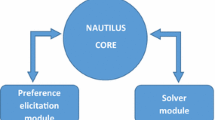Abstract
Interactive decision making arose as a means to overcome the uncertainty concerning the decision maker's (DM) value function. So far the search is confined to nondominated alternatives, which assumes that a win–lose strategy is adopted. The purpose of this paper is to suggest a complementary interactive algorithm that uses an interior point method to solve multiple objective linear programming problems. As the algorithm proceeds, the DM has access to intermediate solutions. The sequence of intermediate solutions has a very interesting characteristic: all of the criteria are improved, that is, a solution  , that follows another solution
, that follows another solution  , has the values of all objectives greater than those of
, has the values of all objectives greater than those of  . This WIN-WIN feature allows the DM to reach a nondominated solution without making any trade-off among the objective functions. However, there is no impediment in proceeding with traditional multiobjective methods.
. This WIN-WIN feature allows the DM to reach a nondominated solution without making any trade-off among the objective functions. However, there is no impediment in proceeding with traditional multiobjective methods.



Similar content being viewed by others
References
Aghezzaf B and Ouaderhman T (2001). An interactive interior point algorithm for multiobjective linear programming problems. Opns Res Lett 29: 163–170.
Arbel A (1993). An interior multiobjective linear programming algorithm. Comput Opns Res 20: 723–735.
Arbel A (1994). Anchoring points and cones of opportunities in interior multiobjective linear programming. J Opl Res Soc 45: 83–96.
Arbel A and Korhonen P (1996). Using aspiration levels in an interactive interior multiobjective linear programming algorithm. Eur J Opl Res 89: 193–201.
Arbel A and Korhonen P (2001). Using objective values to start multiple objective linear programming algorithms. Eur J Opl Res 128: 587–596.
Armand P and Malivert C (1991). Determination of the efficient set in multiobjective linear programming. J Optim Theory Appl 70: 467–489.
Korhonen (2005). Interactive methods. In: Figueira J., Greco S. and Ehrgott M. (eds). Multiple Criteria Decision Analysis: State of the Art Surveys. Springer Verlag: London, pp. 641–666.
Steuer RE (1989). Multiple Criteria Optimization: Theory, Computation, and Application. Wiley: New York.
Trafalis TB, Mishina T and Foote BL (1999). An interior point multiobjective programming approach for production planning with uncertain information. Comput Ind Eng 37: 631–648.
Weng WT and Wen UP (2001). An interior point algorithm for solving linear optimization over the efficient set problems. J Chinese Inst Ind Eng 18: 21–30.
Wierzbicki AP (1980). The Use of Reference Objectives in Multiobjective Optimization. In: Fandel G. and Gal T. (eds). Multiple Objective Decision Making, Theory and Application. Springer-Verlag: New York, pp. 468–486.
Author information
Authors and Affiliations
Corresponding author
Rights and permissions
About this article
Cite this article
Junior, H., Lins, M. A WIN-WIN approach to multiple objective linear programming problems. J Oper Res Soc 60, 728–733 (2009). https://doi.org/10.1057/palgrave.jors.2602589
Received:
Accepted:
Published:
Issue Date:
DOI: https://doi.org/10.1057/palgrave.jors.2602589




